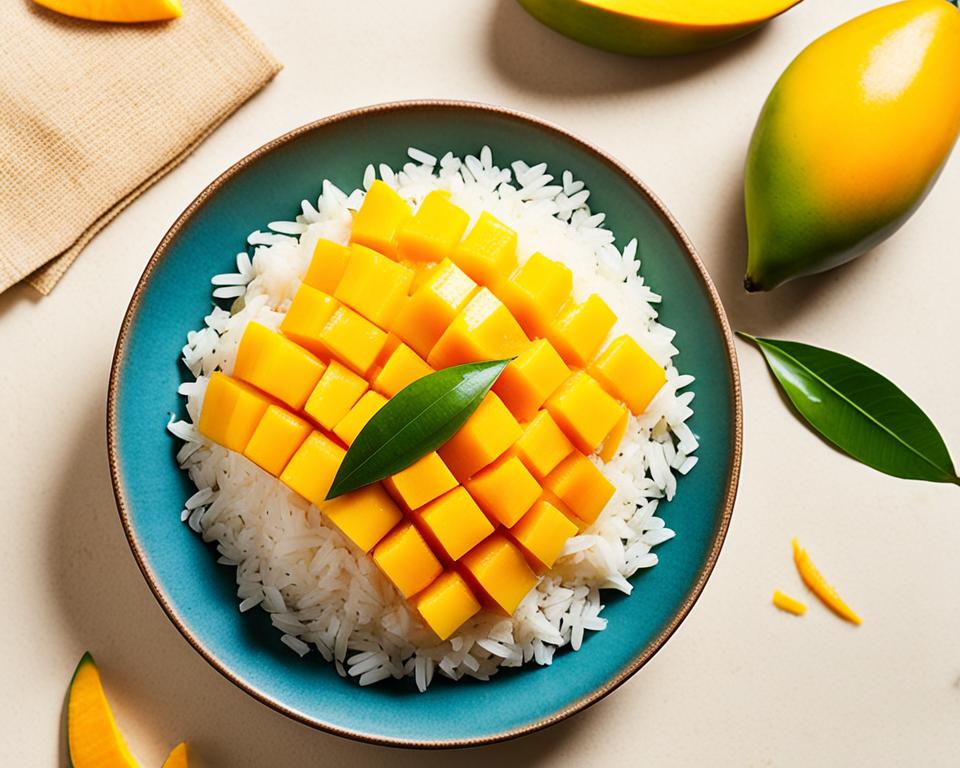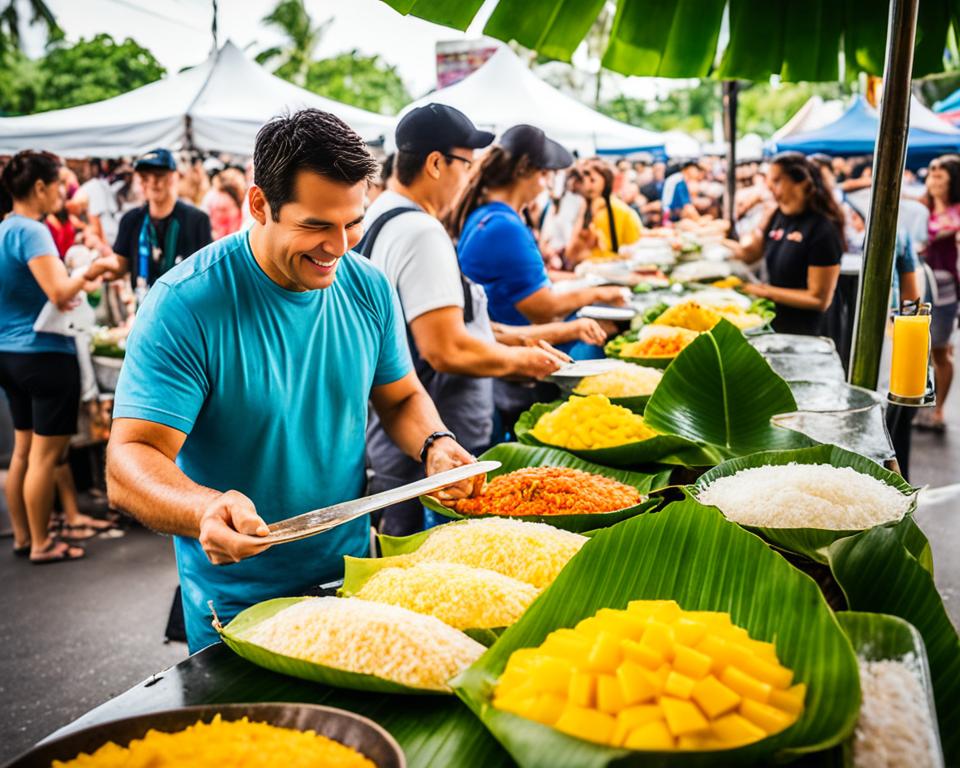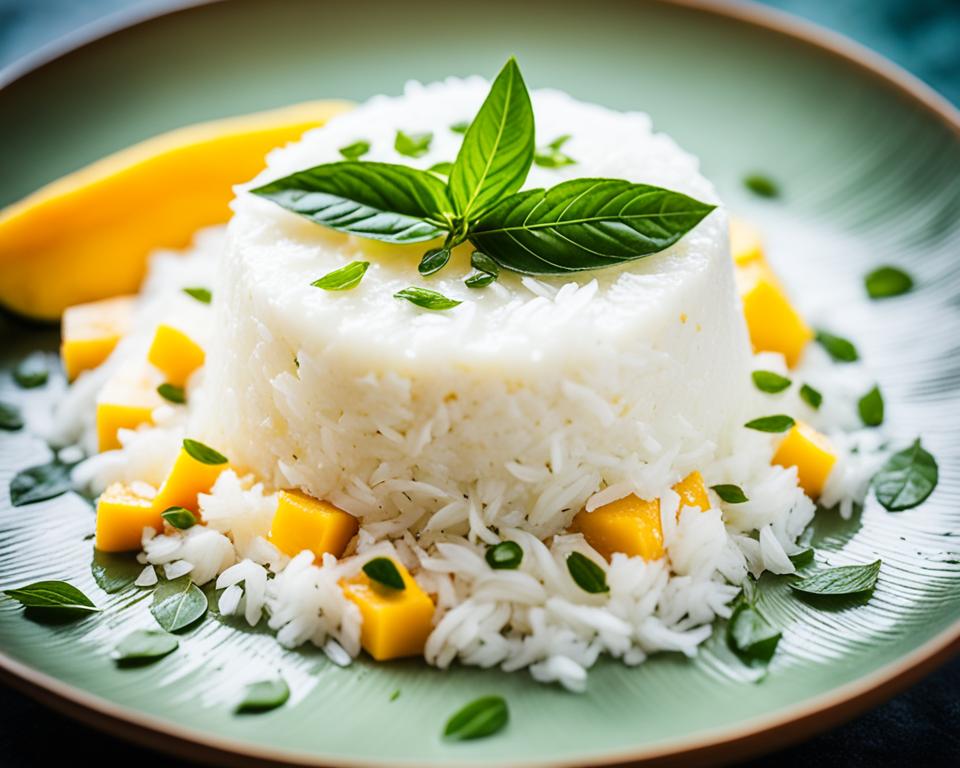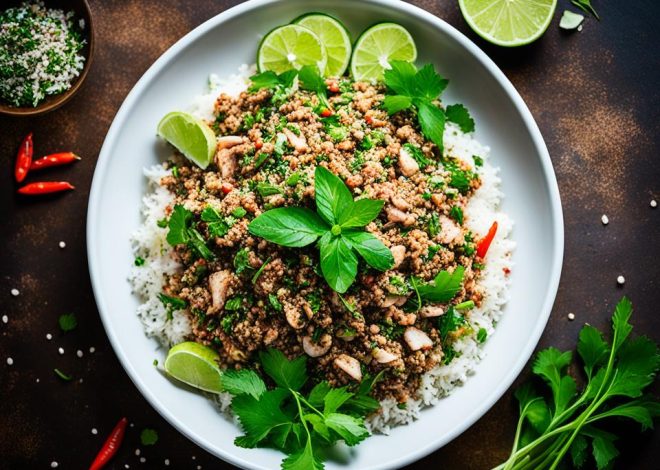
Thai Mango Sticky Rice: Tropical Dessert Delight
Welcome to the tantalizing world of Thai Mango Sticky Rice, an authentic Thai dessert that will transport your taste buds to the tropical paradise of Thailand. This beloved dessert, also known as khao niao mamuang, combines the sweetness of ripe mangoes with the creamy texture of sticky rice, offering a harmonious blend of flavors that will leave you craving more.
Thai Mango Sticky Rice has gained immense popularity worldwide for its unique taste and cultural significance. As an authentic Thai dessert, it represents the rich culinary heritage of Thailand and reflects the country’s love affair with tropical fruits and aromatic flavors.
Are you ready to embark on a journey that will awaken your senses and satisfy your sweet tooth? Let’s dive into the fascinating world of Thai Mango Sticky Rice!
Experience the vibrant colors and irresistible flavors of Thai Mango Sticky Rice, a heavenly dessert that encapsulates the essence of Thailand. In the upcoming sections, we’ll explore the origins of this traditional delicacy, the key ingredients that make it so irresistible, and a step-by-step guide to creating your own mouthwatering masterpiece at home.
Get ready to indulge in the tropical magic of Thai Mango Sticky Rice, a dessert that will transport you to the bustling streets of Thailand with every spoonful.
Read more interesting information at ::i-pasta
What is Thai Mango Sticky Rice?
Thai Mango Sticky Rice, also known as “Khao Niaow Ma Muang” in Thai, is a delicious and popular traditional Thai dessert. This authentic Thai dessert is loved for its unique combination of flavors and textures, blending the sweetness of ripe mangoes with the rich, creamy taste of sticky rice.
The origins of Thai Mango Sticky Rice can be traced back to the central region of Thailand, where it has been enjoyed for centuries. It is often associated with special occasions and festivals, showcasing its cultural significance in Thai cuisine.
Cultural Significance
Thai Mango Sticky Rice holds a special place in Thai culture as a symbol of harvest and abundance. It is traditionally served during the mango season, which occurs from April to June, when the mangoes are at their peak ripeness. This dessert is often showcased during Thai festivals, such as the Songkran festival, where families and friends come together to celebrate the Thai New Year.
“Thai Mango Sticky Rice is not just a dessert, but a representation of Thai culinary heritage and the unique flavors of Thailand.”
This traditional dessert has gained international recognition and has become a favorite among both locals and tourists visiting Thailand. Its delightful combination of sweet mangoes and sticky rice has made it a must-try dish for anyone looking to experience authentic Thai flavors.
In the next section, we will explore the essential ingredients required to create this delectable Thai dessert.
The Ingredients for Mango Sticky Rice
To create the delectable Thai Mango Sticky Rice, you will need a handful of essential ingredients that come together to create a harmonious blend of flavors. Here are the key components:
- Sweet Sticky Rice: Also known as glutinous rice or sticky rice, this type of rice is the foundation of the dish. It gets its unique stickiness from a higher starch content compared to regular rice, resulting in a desirable chewy texture.1
- Ripe Mangoes: The star of the dish, ripe mangoes lend their tropical sweetness and vibrant color to the dessert. Opt for mangoes with a fragrant aroma and firm, yet slightly soft flesh for the best taste and texture.2
- Coconut Milk: The creamy and rich coconut milk is a crucial component that binds all the flavors together. It adds a luscious and indulgent element to the dish, complementing the sweetness of the mangoes and the sticky rice.3
- Sugar: A touch of sweetness is added with the use of sugar. The amount can be adjusted to personal preference, keeping in mind that the dish should not be overwhelmingly sweet, as the natural sweetness of the mangoes and coconut milk already shine through.4
- Salt: A pinch of salt balances the sweetness in Thai Mango Sticky Rice, enhancing the overall flavor profile. It helps to bring out the natural sweetness and prevent the dish from tasting overly sugary.5
By combining these simple yet essential ingredients, you can create the mouthwatering delight that is Thai Mango Sticky Rice. The next section will delve into the step-by-step process of bringing these ingredients together to create a memorable dessert experience.
1 Traditional Thai Sticky Rice – A Complete Guide: https://www.templeofthai.com/cooking/thai-sticky-rice.php
2 How to Choose the Perfect Ripe Mango: https://www.thespruceeats.com/how-to-choose-and-cut-a-mango-3217076
3 The Magic of Coconut Milk: https://www.thespruceeats.com/all-about-coconut-milk-3217736
4 How to Make Mango Sticky Rice: https://www.eatingthaifood.com/thai-mango-sticky-rice-recipe-khao-niao-mamuang/
5 Salt in Desserts – The Difference It Makes: https://www.wisegeek.com/what-is-the-role-of-salt-in-desserts.htm
How to Make Mango Sticky Rice: A Step-by-Step Guide
Creating a delicious bowl of Thai Mango Sticky Rice may seem daunting, but with our step-by-step guide, you’ll be able to make this flavorful dessert right in your kitchen. Follow these simple instructions to indulge in the best Mango Sticky Rice!
Ingredients:
- 1 cup of Thai sweet sticky rice
- 2 ripe mangoes
- 3/4 cup of coconut milk
- 1/4 cup of sugar
- A pinch of salt
Step 1: Soaking the Rice
In a bowl, rinse the sticky rice under cold water until the water runs clear. Then, cover the rice with water and let it soak for at least 4 hours or overnight. This will soften the rice for a deliciously chewy texture.
Step 2: Steaming the Rice
After soaking, drain the rice and transfer it to a steamer lined with cheesecloth. Place the steamer over a pot of boiling water and cover it with a lid. Allow the rice to steam for about 25-30 minutes or until it becomes tender.
Step 3: Preparing the Coconut Sauce
While the rice is steaming, you can prepare the coconut sauce. In a saucepan, combine the coconut milk, sugar, and a pinch of salt. Heat the mixture over low heat, stirring until the sugar is dissolved. Remove the saucepan from heat and set aside.
Step 4: Assembling the Dish
Once the rice is done steaming, remove it from the steamer and place it in a bowl. Pour half of the prepared coconut sauce over the rice and gently stir to coat the grains evenly. Let the rice rest for 10 minutes to absorb the flavors.
“The combination of the fragrant sticky rice and the sweet mango is simply irresistible. It’s the perfect balance of flavors and textures, making Thai Mango Sticky Rice a true tropical dessert delight.”
Step 5: Plating the Mango Sticky Rice
To serve, spoon a generous portion of the sweet sticky rice onto a plate. Slice the ripe mangoes and arrange them alongside the rice. Drizzle the remaining coconut sauce over the mangoes and rice, and garnish with a sprinkle of toasted sesame seeds for an added crunch.
Now, it’s time to dig in and enjoy the heavenly combination of sticky rice, sweet mangoes, and creamy coconut sauce. Try this recipe, and you’ll understand why Thai Mango Sticky Rice is considered one of the best desserts in the world!
| Ingredients | Quantity |
|---|---|
| Thai sweet sticky rice | 1 cup |
| Ripe mangoes | 2 |
| Coconut milk | 3/4 cup |
| Sugar | 1/4 cup |
| Salt | A pinch |
Variations of Mango Sticky Rice
While traditional Thai Mango Sticky Rice is a delight on its own, there are various ways to add a twist to this beloved dessert. Thai street food vendors are known for their creativity, offering unique variations that cater to different taste preferences. Here are some popular variations of mango sticky rice:
1. Toppings
One way to elevate the flavors of mango sticky rice is by adding a variety of toppings. Options include toasted sesame seeds, crushed peanuts, or even a sprinkle of coconut flakes. These toppings add texture and dimension to the dish, creating a delightful blend of flavors.
2. Different Types of Rice
While sticky rice is the traditional choice for mango sticky rice, some variations experiment with different types of rice. Jasmine rice, glutinous black rice, or even brown rice can be used as alternatives. Each type of rice brings its own unique texture and flavor profile, offering a different twist to the dish.
3. Additional Ingredients
To add complexity to the dessert, additional ingredients can be incorporated into the mango sticky rice mixture. Some variations include adding pandan leaf extract for a fragrant twist or infusing the coconut milk with vanilla or pandan essence. These additional ingredients enhance the overall taste and aroma, taking mango sticky rice to a whole new level.
Thai street food vendors often experiment with different combinations of toppings, rice choices, and additional ingredients, resulting in a wide array of delicious and innovative mango sticky rice variations. Whether you prefer a classic rendition or enjoy exploring new flavors, there is a mango sticky rice variation to satisfy every palate.
| Variation | Description |
|---|---|
| Toppings | Additional toppings such as sesame seeds, crushed peanuts, or coconut flakes. |
| Different Types of Rice | Variations using jasmine rice, glutinous black rice, or brown rice. |
| Additional Ingredients | Incorporation of ingredients like pandan leaf extract or vanilla essence. |
“Thai street food vendors often experiment with different combinations of toppings, rice choices, and additional ingredients, resulting in a wide array of delicious and innovative mango sticky rice variations.”
The Perfectly Ripe Mango: A Key Ingredient
When it comes to creating the ultimate Thai Mango Sticky Rice, one cannot overlook the importance of using perfectly ripe mangoes. These luscious fruits not only add a burst of vibrant flavor to the dessert but also bring a natural sweetness that complements the sticky rice and coconut milk.
Authentic Thai desserts, like Mango Sticky Rice, celebrate the abundance of tropical fruits found in the region. Mangoes, in particular, take center stage with their juicy texture and distinct aroma. To fully enjoy the authentic Thai dessert experience, it is crucial to select mangoes that are ripe and flavorful.
“The perfectly ripe mango is essential in creating a harmonious balance of flavors in Mango Sticky Rice.”
When choosing mangoes for this delectable dessert, look for ones that are slightly soft to the touch but not overly mushy. The skin should have a bright, golden hue, indicating that the fruit is at its peak ripeness. Avoid mangoes that have green patches or blemishes as they may not offer the same level of sweetness.
Pro tip: To ensure you’re using ripe mangoes, pay attention to the fragrance. A ripe mango should have a sweet, floral scent that is enticing and irresistible.
When it comes to varieties, the Ataulfo or Champagne mango is a popular choice for Mango Sticky Rice due to its smooth flesh and rich flavor. However, other ripe mango varieties such as Alphonso, Keitt, or Haden can also be used to create a delightful twist on the classic dessert.
Remember, the intensity of the mango flavor will greatly impact the overall taste of the dish. Choosing perfectly ripe mangoes ensures that each bite of Thai Mango Sticky Rice is a tropical delight, showcasing the authentic flavors of Thailand.
The Role of Sweet Sticky Rice in Mango Sticky Rice
One of the key ingredients that gives Thai Mango Sticky Rice its delightful texture and taste is sweet sticky rice. Also known as glutinous rice or sticky rice, this unique variety of rice is a staple in Thai cuisine, particularly in desserts. Unlike regular rice, sweet sticky rice has a higher starch content, giving it a sticky and chewy texture when cooked.
The process of cooking sweet sticky rice involves soaking it in water for several hours before steaming it. This method allows the grains to absorb water and become plump and sticky. The end result is a soft and chewy rice that pairs perfectly with the creamy coconut sauce and sweet mango slices.
The sticky texture of this rice adds a pleasing mouthfeel to each bite of Mango Sticky Rice. It creates a delightful contrast with the juicy and ripe mangoes, enhancing the overall sensory experience. The subtle sweetness of the rice also complements the natural sweetness of the mangoes, creating a harmonious blend of flavors.
Health Benefits of Sweet Sticky Rice
In addition to its culinary properties, sweet sticky rice also offers some health benefits. It is a good source of carbohydrates and provides energy for the body. The sticky nature of the rice slows down digestion, resulting in a slower release of glucose into the bloodstream and providing a sustained energy boost.
Sweet sticky rice is also gluten-free, making it a suitable option for individuals with gluten sensitivities or celiac disease. It is low in fat and contains some essential minerals like iron and zinc.
Furthermore, because sweet sticky rice is eaten in moderation as a dessert, it can be enjoyed as part of a balanced diet without causing significant health concerns.
Using Sweet Sticky Rice in Other Dishes
While sweet sticky rice is most commonly associated with Thai Mango Sticky Rice, it is also used in various other traditional Thai desserts such as coconut sticky rice with mango, sticky rice with taro, and sticky rice with coconut custard.
Additionally, sweet sticky rice can be utilized in savory dishes, particularly in Southeast Asian cuisines. It is often used to make rice dumplings, rice balls, and rice cakes, offering a unique and satisfying texture to these dishes.
An Essential Ingredient
When it comes to Thai Mango Sticky Rice, sweet sticky rice plays a vital role in creating the distinct texture and taste that this dessert is known for. Its sticky and chewy nature adds a delightful element to each bite and complements the sweet juiciness of the mangoes. Whether enjoyed as a traditional Thai dessert or as part of other dishes, sweet sticky rice is a versatile ingredient that adds a unique touch to culinary creations.
Coconut Milk: The Creamy Element
One of the key components that lends Thai Mango Sticky Rice its luscious and creamy texture is coconut milk. This rich and flavorful ingredient not only adds a heavenly creaminess to the dessert but also complements the sweetness of the ripe mangoes and sticky rice.
Coconut milk is made by extracting the liquid from the grated flesh of mature coconuts. It is widely used in Thai cuisine and serves as a versatile ingredient in both sweet and savory dishes. In the context of Thai Mango Sticky Rice, coconut milk plays a crucial role in creating a delectable coconut-infused sauce that coats and permeates every bite of the rice.
To make the coconut sauce for Mango Sticky Rice, coconut milk is gently simmered with sugar and a pinch of salt, infusing the creamy liquid with a delicate balance of sweetness and savory undertones. This silky sauce is then poured generously over the steamed sticky rice, allowing it to absorb the flavors and further enhancing its natural aroma.
Coconut milk not only adds depth of flavor but also imparts a velvety mouthfeel to the dessert. Its natural fats create a luxurious texture that pairs perfectly with the tender grains of sweet sticky rice and the juicy, succulent mango slices.
In Thai cuisine, coconut milk is celebrated for its ability to enhance the taste and richness of traditional dishes. Its inclusion in Thai Mango Sticky Rice elevates the dessert, transforming it into a decadent and unforgettable indulgence.
To fully appreciate the role of coconut milk in creating the creamy and irresistible appeal of Thai Mango Sticky Rice, let’s explore a recipe that showcases this delightful ingredient in all its glory:
| Coconut Milk Sauce for Thai Mango Sticky Rice | |
|---|---|
| Ingredients: | Instructions: |
|
|
With this luxurious coconut milk sauce, your Thai Mango Sticky Rice will be transformed into a heavenly dessert that delights the senses and transports you to the exotic flavors of Thailand.
Sugar and Salt: The Balancing Act
In the art of creating Thai Mango Sticky Rice, achieving the perfect balance of sweetness and saltiness is crucial. The combination of these two contrasting flavors elevates the taste profile of this beloved dessert. Sugar and salt play pivotal roles in striking this delicate balance.
When preparing the sticky rice, a sweet component is added to enhance its natural flavor. Typically, palm sugar is used as the sweetener of choice in this recipe. The rich, caramel-like taste of palm sugar complements the creamy texture of the rice, creating a luxurious sweetness that is not overpowering. This touch of sweetness serves as the perfect base for the vibrant flavors of ripe mangoes and coconut.
On the other hand, salt acts as a subtle yet essential element in Thai Mango Sticky Rice. It helps to enhance the overall flavor profile by providing a subtle contrast to the sweetness. Just a pinch of salt is added to the coconut sauce, harmonizing the flavors and preventing the dessert from becoming overly saccharine. The saltiness serves as a perfect counterbalance, ensuring every bite is both indulgent and satisfying.
“The balance of sweetness and saltiness is what makes Thai Mango Sticky Rice such a delightful treat for the taste buds.”
With the right balance of sweetness and saltiness, Thai Mango Sticky Rice achieves a harmonious blend of flavors that delights the palate. This delicate balancing act requires careful attention to detail and a deep understanding of flavor profiling.
Tips for Balancing Sweetness and Saltiness
- Experiment with different types of sweeteners, such as coconut sugar or condensed milk, to achieve your desired level of sweetness.
- Use high-quality sea salt or Himalayan pink salt for a subtle, nuanced flavor.
- Remember that the sweetness of the mangoes plays a significant role in the overall balance. Opt for ripe mangoes that are naturally sweet and juicy.
- Taste the coconut sauce as you add the salt, adjusting the amount based on your personal preference for the perfect sweet-salty equilibrium.
By mastering the art of balancing sweetness and saltiness, you can create a delectable Thai Mango Sticky Rice that will transport you to the streets of Thailand with every bite.
Serving and Presentation of Mango Sticky Rice
When it comes to Thai Mango Sticky Rice, the presentation is just as important as the taste. The vibrant colors and enticing display make this dessert a feast for the eyes as well. To create an authentic Thai street food experience in your own home, here are some tips on how to serve and present your Mango Sticky Rice:
Garnishes
Thai cuisine is known for its beautiful garnishes, and Mango Sticky Rice is no exception. To enhance the visual appeal, consider adding a sprinkle of toasted sesame seeds or crushed peanuts on top. These garnishes not only add a delightful crunch but also provide a contrast in texture.
Plating
Place a generous portion of sweet sticky rice on a serving dish or plate. Arrange slices of ripe mango on top of the rice, creating an attractive arrangement. The vibrant orange hue of the mangoes against the white rice adds to the dessert’s visual appeal. You can also drizzle some of the coconut sauce over the rice and mangoes for a beautiful finishing touch.
Presentation Techniques
If you want to take your presentation to the next level, consider using a mold to shape the sweet sticky rice into a pyramid or a heart. This technique adds an element of elegance and sophistication to your dessert. Alternatively, you can also use a cookie cutter to create fun shapes with the rice.
“The presentation of Thai Mango Sticky Rice is an opportunity to showcase your creativity and attention to detail. With a little effort, you can transform a simple dessert into a stunning masterpiece.”
Remember, the presentation is an essential aspect of the overall dining experience. Taking the time to thoughtfully serve and present your Mango Sticky Rice will elevate the enjoyment of this delicious Thai street food dessert.

Mango Sticky Rice Across Cultures
Thai Mango Sticky Rice, known as a beloved authentic Thai dessert, has transcended its origins and gained popularity around the world. This delectable treat has been adapted in various cultures, captivating dessert enthusiasts with its unique blend of flavors and textures.
“Mango Sticky Rice is a delightful harmony of sweet, creamy, and aromatic elements. Its popularity has led to its adoption as an iconic dessert in Thai restaurants globally.” – Chef Somsri, a renowned Thai cuisine expert.
Thai restaurants internationally often feature Mango Sticky Rice on their menus, catering to the growing demand for authentic Thai desserts. This showcases the dessert’s widespread appeal and its ability to transport people to the vibrant streets of Thailand through its flavors.
One adaptation of Mango Sticky Rice in other cultures involves incorporating local fruits in place of mangoes, creating an exciting fusion of flavors. For example, in Hawaii, ripe pineapple is sometimes substituted for mangoes, complementing the sticky rice with its tropical sweetness.
Another interesting rendition of Mango Sticky Rice can be found in Japan, where matcha (green tea) is used to flavor the sticky rice, infusing it with a unique earthy taste. This infusion of Japanese influence adds a delightful twist to the traditional Thai dessert, attracting both locals and tourists alike.
Similarly, in the United States, chefs have experimented with incorporating different fruity flavors into the sticky rice, such as strawberries or peaches, to create innovative and refreshing variations of this beloved dessert.
Mango Sticky Rice: A Globally Recognized Delight
The global popularity of Thai Mango Sticky Rice can be attributed to its harmonious combination of flavors, ease of preparation, and its ability to transport one’s taste buds to the tropical paradise of Thailand. Whether enjoyed in its traditional form or as a creative adaptation, Mango Sticky Rice continues to captivate dessert lovers worldwide.
A plate of mouth-watering Mango Sticky Rice, a globally recognized authentic Thai dessert.
Health Benefits of Mango Sticky Rice
Mango sticky rice not only delights the taste buds but also offers several potential health benefits. This beloved Thai dessert combines the nutritional goodness of mangoes and the fiber-rich sticky rice, creating a treat that is both indulgent and nourishing.
Mangoes: A Nutritional Powerhouse
Mangoes are not only delicious but also packed with essential vitamins and minerals. They are rich in vitamin C, which plays a vital role in supporting the immune system and promoting collagen production for healthy skin. Additionally, mangoes provide vitamin A, which is beneficial for eye health and helps maintain healthy skin and mucous membranes. The vibrant yellow-orange fruit is also a good source of dietary fiber, aiding in digestion and promoting a healthy gut.
“Mangoes are a nutritious fruit that adds a burst of tropical flavor to mango sticky rice. They are a great source of vitamins C and A, as well as dietary fiber.”
– Dr. Maria Rodriguez, Nutritionist
Fiber-Rich Sticky Rice
The sticky rice used in mango sticky rice is a type of short-grain rice that has a slightly sweet flavor and a sticky texture when cooked. This variety of rice is a good source of dietary fiber, providing essential roughage that aids in digestion and promotes feelings of fullness. The fiber content in sticky rice helps regulate blood sugar levels and can contribute to improved cardiovascular health.
Balance and Moderation
While mango sticky rice offers potential health benefits, it is important to enjoy it in moderation as part of a balanced diet. The dish does contain sugar and should be consumed in appropriate portions to maintain a healthy lifestyle.
Now that you have learned about the potential health benefits of mango sticky rice, it’s time to indulge in this delightful dessert with a guilt-free mindset!
Enjoy a delicious serving of mango sticky rice, savoring the tropical flavors and reaping the potential health benefits it offers.
Thai Mango Sticky Rice: A Dessert for All Seasons
Thai Mango Sticky Rice is a versatile and delightful dessert that can be enjoyed throughout the year. Its popularity as an authentic Thai dessert knows no bounds, transcending seasons and captivating taste buds around the world.
What makes Thai Mango Sticky Rice so special is its ability to adapt to different occasions and climates. Whether it’s a hot summer day or a cozy winter evening, this dessert never fails to satisfy.
During the summer months, Thai Mango Sticky Rice offers a refreshing and cooling treat. The juicy sweetness of ripe mangoes perfectly complements the creamy coconut-infused sticky rice, providing a burst of tropical flavors that is both refreshing and satisfying.

In the colder seasons, Thai Mango Sticky Rice brings warmth and comfort. Served warm or slightly chilled, the rich and creamy texture of the sticky rice, combined with the luscious sweetness of the mangoes, creates a comforting dessert that soothes the soul and indulges the senses.
Whether it’s a sunny beach picnic, a festive holiday gathering, or a cozy night at home, Thai Mango Sticky Rice is a dessert that can be enjoyed year-round. Its versatile nature makes it suitable for any occasion, adding a touch of exotic indulgence to your culinary repertoire.
So, the next time you find yourself craving a delightful dessert, consider making Thai Mango Sticky Rice. It’s a dessert that transcends seasons, bringing the authentic flavors of Thailand to your plate.
Conclusion
In conclusion, Thai Mango Sticky Rice is a tropical delight that has gained worldwide popularity as an authentic Thai dessert. With its unique blend of sweet sticky rice, perfectly ripe mangoes, creamy coconut milk, and a touch of sweetness and saltiness, this dessert offers a delightful combination of flavors and textures.
Whether enjoyed as a street food snack in Thailand or served in upscale Thai restaurants internationally, Thai Mango Sticky Rice has become a beloved and accessible dessert for all seasons. Its versatility makes it suitable for any occasion, and its cultural significance adds an extra layer of depth to the overall experience.
Whether you are a fan of Thai cuisine or simply looking to indulge in a refreshing and satisfying dessert, Thai Mango Sticky Rice is sure to satisfy your cravings. So, next time you have the opportunity, don’t miss the chance to experience the tropical delight of Thai Mango Sticky Rice.


